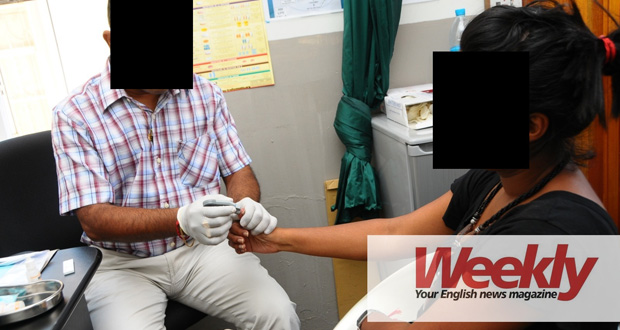Publicité
Second case of full remission from HIV. What does the breakthrough actually entail?
Par
Partager cet article
Second case of full remission from HIV. What does the breakthrough actually entail?

This article was published in Weekly No. 340 of 14 March 2019.
After a second case of full remission from HIV was recorded last week, worldwide hope for a cure for the disease was rekindled. What does this rare case of remission actually entail and what should Mauritian patients expect from it? The complexity of this breakthrough – which involved bone marrow transplant rather than medication – calls for restraint in the hope for a generalised cure to this deadly virus which still kills a million people a year worldwide.
The news was welcomed with a revived glimmer of hope. Doctors announced in the journal Nature that a HIV-infected man, referred to as the “London patient”, had shown no sign of the virus for almost 19 months. This second case of sustained remission comes 10 years after the first confirmed one when another man, the “Berlin patient”, became the first sustained remission survivor.
Both patients underwent a bone marrow transplant to treat blood cancer. They received stem cells from donors with a genetic mutation present in less than one per cent of Europeans which prevents the expression of an HIV receptor, known as CCR5, AFP reports. The London patient thus received two copies of a CCR5 gene variant, which is resistant to most HIV-1 strains. Speaking to the AFP, Ravindra Gupta, professor at the University of Cambridge and the study’s lead author, confirmed the news was a “landmark”. “After 10 years of not being able to replicate [the first case], people were wondering if this was a fluke. I think it is important to reaffirm that this is real and it can be done,” he said, “CCR5 is something essential for the virus to complete its life-cycle […] and we know that CCR5 can be knocked out without any serious consequences because people are walking around without that gene.”
The London patient followed a milder form of treatment than the Berlin one, which goes to show that milder forms of treatment can lead to full remission too. Indeed, while the latter received two transplants 10 years ago, had two rounds of chemotherapy as the first one failed to work, and underwent full body irradiation – which almost killed him – to treat leukaemia, the London patient on the other hand went through a single and milder chemotherapy and was not irradiated. “Radiation has a lot of side-effects and leads to a delayed recovery of the bone marrow, so it’s really good that we’ve shown you don’t need radiation,” Gupta told the AFP.
“The rarity of donors with the sought-after genetic mutation indeed renders the breakthrough inaccessible to most of the estimated 37 million people living with HIV worldwide.”
The London patient remained on antiretroviral therapy for 16 months after the bone marrow transplant, at which point the treatment was interrupted. Regular testing has demonstrated that the patient’s viral load has remained undetectable since then (see inset).
Although this news has brought hope that a cure is “feasible”, as Sharon Lewin, the director of the Peter Doherty Institute for Infection and Immunity, told the AFP, Gupta remained cautious at a press conference in Seattle, USA, avoiding the use of the word “cure”. “In another six months or two years, things will be clearer,” he declared instead. The rarity of donors with the sought-after genetic mutation indeed renders the ‘breakthrough’ inaccessible to most of the estimated 37 million people living with HIV worldwide.

“It’s now easier to control one’s HIV than diabetes.”
In Mauritius, this second case of remission was welcomed with euphoria too. For Nicolas Ritter, the executive director of NGO Prévention, Information et Lutte contre le SIDA (PILS), “It’s good news for both the patient and research,” while Anne Marie Cupidon Guiliani, manager of the NGO Collectif Urgence Toxida (CUT), says the news is a “message of hope for all those sero-infected, sero-affected or sero-concerned.” Although they both concede that though the scientific community has now realised that the first case was no fluke, Ritter and Cupidon Guiliani still call for restraint. “About 20 other patients underwent unsuccessful bone marrow transplant previously; they either died of cancer or of other infections caused by HIV,” declares Ritter. “It’s too early to jump to conclusions about the potential to replicate this process in general and, more particularly, in Mauritius,” tempers Cupidon Guiliani.
Ritter nonetheless believes hope is allowed. “When I was diagnosed with HIV in 1994, antiretroviral therapy was in its infancy and was not as efficient as nowadays. Yet, my doctor told me to keep faith and that with scientific advances, the efficiency of the treatment would improve.” Today, antiretroviral therapy allows HIV patients to have an undetectable viral load and not to transmit the virus. Sero-negative people also have access to pills which reduce the risk of infection. The post-exposure prophylaxis (PEP) is an emergency treatment to be taken within the first hours after being exposed to HIV. Likewise, preexposure prophylaxis (PrEP), available in Mauritius since last year, protects populations at risk (homosexuals, sex workers and drug users) from getting infected with recorded efficiency rates of up to 92 per cent. “PrEP protects from HIV like some medicines protect from malaria or contraceptive pills shield from pregnancy,” says Cupidon Guiliani. Ritter remarks that “it’s now easier to control one’s HIV than diabetes”.
Isn’t the continuous improvement in the efficiency of HIV treatment eroding the apprehension and mistrust people had developed towards contracting HIV? “Fear has never been a good prevention tool,” Ritter says. “We all know cigarettes cause cancer; yet, people still smoke.” The executive director of PILS claims that fear triggers “stigma, prejudice and rejection”. Instead, he advocates even greater sensitisation, education and awareness as effective preventive approaches.
While the second case of confirmed remission from HIV brought hope to many that a cure would finally see the light of day, the technicalities of this scientific prowess demonstrate that a generalised medicated solution to the HIV pandemic remains elusive. As pointed out by NGOs, the best antidotes to the virus remain prevention, awareness, and greater access to healthcare.
HIV kills 1 million worldwide a year despite existing treatments
<p style="text-align: justify;">Almost 37 million people live with HIV across the world, with only 59 per cent receiving antiretroviral therapy. Close to one million people die each year from HIV-related causes worldwide. Nicolas Ritter, executive director of PILS, says the high mortality rate can be explained by the “life of denial” several infected people lead. “Due to stigma and prejudice, many people living with the virus either do not get tested or follow any treatment out of fear or shame.”</p>
<p style="text-align: justify;">In Mauritius, as at June 2018, 7,508 people had been diagnosed with HIV (7,230 Mauritians and 278 foreigners) since the first HIV case was recorded in 1987. Out of these, only 46 per cent actually follow the treatment, according to Cupidon Guiliani.</p>
<p style="text-align: justify;">Antiretroviral therapy consists in taking between one and three pills daily depending on the protocol, Ritter says. The treatment keeps the virus in check by preventing it from multiplying and attacking other white blood cells. “The immune system then goes back up and the patient doesn’t develop opportunistic infections. That means the patient’s condition doesn’t evolve into the AIDS stage,” Ritter states. Antiretroviral therapy is a life-long treatment since AIDS is a chronic disease. Stopping the treatment leads to a “viral relapse” and a possible resistance to the protocol, warns Ritter. “The patient might have to switch to another protocol if they resume their therapy.”</p>
<p style="text-align: justify;">Following antiretroviral therapy helps patients to reach an undetectable viral load which happens when the number of copies of HIV present in one millilitre of blood (the viral load) cannot be detected by standard viral load tests. An undetectable viral load means less HIV in a patient’s body, less risk to the immune system and a longer and healthier life. Transmission risks are also reduced by up to 96 per cent. That is the state we wish on anyone living with HIV.</p>
Publicité
Publicité
Les plus récents






